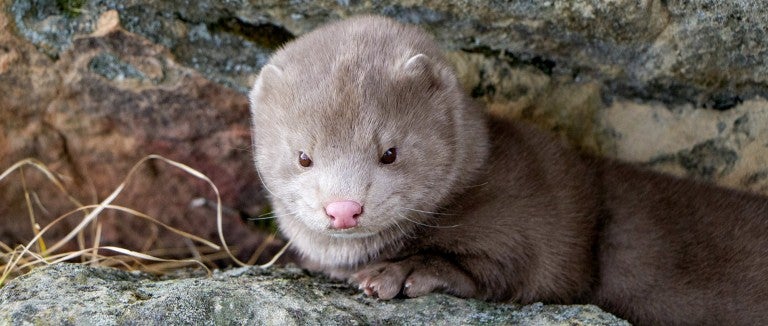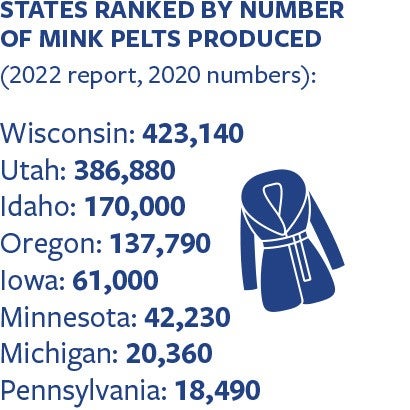Editor’s note: A few weeks after this issue of All Animals went to press, a bill to prohibit mink farming was introduced in Congress. Learn more—including how you can support the bill—on our blog.
When Wyoming rescuer Megan Carfino encountered a farmed mink for the first time—she volunteered to transport him from South Dakota to Montana—the animal seemed to her like a mythical creature. He was bigger and lighter colored than the brown-coated American minks she had seen in the wild. For a century and a half, farmed mink have been bred for their pelts, marketed in shades such as mahogany, blue iris, sapphire and pearl. Jaques—who had escaped from a farm in Ontario, Canada, and was on his way to a West Coast sanctuary—was tan, or “fawn.” What struck Carfino most was his expression.
“He had an amazingly intelligent face,” says Carfino, who cared for the farmed mink for a day or two at her rescue in Sheridan and then took him on the next leg of his journey. “He was magical.”
In the wild, mink are solitary and territorial. They spend their time swimming, fishing, digging and exploring. On fur farms in the U.S. and elsewhere, they are confined to rows of small wire cages, often several to a cage, from soon after birth until they are gassed at age 9 months.
The conditions thwart their instincts, says professor Alastair MacMillan, veterinary adviser for Humane Society International. “You couldn’t think of anything further from their natural environment.”
The value of U.S. mink production declined by more than half, from $122,742,888 in 2017 to $59,933,885 in 2021.
On mink farms, the only water flows from automated systems that fill drinking bowls in cages. Two times a day, a machine called a Minkomatic drives up and down the rows to deliver a slurry of meat and food production byproducts through the cage tops. Bored, anxious and frustrated, the mink pace and sway their bodies and their heads. They fight. They dig at and chew on the wire until their noses tear open and their teeth and nails break. They pick and groom their skin until it bleeds.
Nearly 20 countries have already banned the farming of mink, responding to the cruelty of raising these wild animals in captivity and the risk farms with thousands of stressed, crowded mink pose to public health. The Humane Society of the United States hopes to see a bill introduced soon in Congress that would ban the farming of mink for fur in the U.S. Mink are particularly susceptible to COVID-19, which humans have passed to farmed mink and which farmed mink have passed back to humans and to other mink, including those in the wild. They are also susceptible to avian flu, which this year sickened mink fed poultry on a farm in Spain and then spread from mink to mink.
A potential bill could offer mink farmers money to compensate them for the cost of closing their businesses and the market value of buildings and equipment, helping them transition either to another source of income or retirement, says Haley Stewart, HSUS program manager for wildlife protection public policy. “It would allow them out of a dying industry.”
As demand for fur has fallen, mink farming has shrunk in the U.S. The number of mink pelts produced in the country fell by three-quarters during the last 50 years—from 5.7 million in 1969 to 1.44 million in 2021, according to U.S. Department of Agriculture statistics. The number of mink farms in Wisconsin, Utah, Idaho and Oregon (the first, second, third and fourth top producers) and 18 other states dropped by more than 90%—from 2,800 in 1969, according to the USDA, to less than 250 and perhaps as low as 120.
Want more content like this?
This was written and produced by the team behind All Animals, our award-winning magazine. Each issue is packed with inspiring stories about how we are changing the world for animals together.
Learn MoreSubscribe

